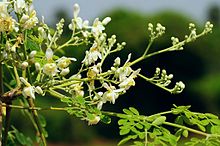Muringa
| Moringa oleifera | |
|---|---|
 |
|
| Scientific classification | |
| Kingdom: | Plantae |
| (unranked): | Angiosperms |
| (unranked): | Eudicots |
| (unranked): | Rosids |
| Order: | Brassicales |
| Family: | Moringaceae |
| Genus: | Moringa |
| Species: | M. oleifera |
| Binomial name | |
|
Moringa oleifera Lam. |
|
| Synonyms | |
|
|
| Nutritional value per 100 g (3.5 oz) | |
|---|---|
| Energy | 64 kcal (270 kJ) |
|
8.28 g
|
|
| Dietary fiber | 2.0 g |
|
1.40 g
|
|
|
9.40 g
|
|
| Vitamins | |
| Vitamin A equiv. |
(47%)
378 μg |
| Thiamine (B1) |
(22%)
0.257 mg |
| Riboflavin (B2) |
(55%)
0.660 mg |
| Niacin (B3) |
(15%)
2.220 mg |
| Pantothenic acid (B5) |
(3%)
0.125 mg |
| Vitamin B6 |
(92%)
1.200 mg |
| Folate (B9) |
(10%)
40 μg |
| Vitamin C |
(62%)
51.7 mg |
| Minerals | |
| Calcium |
(19%)
185 mg |
| Iron |
(31%)
4.00 mg |
| Magnesium |
(41%)
147 mg |
| Manganese |
(17%)
0.36 mg |
| Phosphorus |
(16%)
112 mg |
| Potassium |
(7%)
337 mg |
| Sodium |
(1%)
9 mg |
| Zinc |
(6%)
0.6 mg |
| Other constituents | |
| Water | 78.66 g |
|
|
| Percentages are roughly approximated using US recommendations for adults. Source: USDA Nutrient Database |
|
| Nutritional value per 100 g (3.5 oz) | |
|---|---|
| Energy | 37 kcal (150 kJ) |
|
8.53 g
|
|
| Dietary fiber | 3.2 g |
|
0.20 g
|
|
|
2.10 g
|
|
| Vitamins | |
| Vitamin A equiv. |
(1%)
4 μg |
| Thiamine (B1) |
(5%)
0.0530 mg |
| Riboflavin (B2) |
(6%)
0.074 mg |
| Niacin (B3) |
(4%)
0.620 mg |
| Pantothenic acid (B5) |
(16%)
0.794 mg |
| Vitamin B6 |
(9%)
0.120 mg |
| Folate (B9) |
(11%)
44 μg |
| Vitamin C |
(170%)
141.0 mg |
| Minerals | |
| Calcium |
(3%)
30 mg |
| Iron |
(3%)
0.36 mg |
| Magnesium |
(13%)
45 mg |
| Manganese |
(12%)
0.259 mg |
| Phosphorus |
(7%)
50 mg |
| Potassium |
(10%)
461 mg |
| Sodium |
(3%)
42 mg |
| Zinc |
(5%)
0.45 mg |
| Other constituents | |
| Water | 88.20 g |
|
|
| Percentages are roughly approximated using US recommendations for adults. Source: USDA Nutrient Database |
|
Moringa oleifera is the most widely cultivated species of the genus Moringa, which is the only genus in the family Moringaceae. English common names include: moringa,drumstick tree (from the appearance of the long, slender, triangular seed-pods), horseradish tree (from the taste of the roots, which resembles horseradish), ben oil tree, or benzoil tree (from the oil which is derived from the seeds). It is a fast-growing, drought-resistant tree, native to the southern foothills of the Himalayas in northwestern India, and widely cultivated in tropical and subtropical areas where its young seed pods and leaves are used as vegetables. It can also be used for water purification and hand washing, and is sometimes used in herbal medicine.
Moringa derives from the Tamil word, 'murungai', referring to a twisted pod found in young fruit.
M. oleifera is a fast-growing, deciduous tree that can reach a height of 10–12 m (32–40 ft) and trunk diameter of 45 cm (1.5 ft). The bark has a whitish-grey colour and is surrounded by thick cork. Young shoots have purplish or greenish-white, hairy bark. The tree has an open crown of drooping, fragile branches and the leaves build up a feathery foliage of tripinnate leaves.
The flowers are fragrant and bisexual, surrounded by five unequal, thinly veined, yellowish-white petals. The flowers are about 1.0-1.5 cm (1/2") long and 2.0 cm (3/4") broad. They grow on slender, hairy stalks in spreading or drooping flower clusters which have a length of 10–25 cm.
Flowering begins within the first six months after planting. In seasonally cool regions, flowering only occurs once a year between April and June. In more constant seasonal temperatures and with constant rainfall, flowering can happen twice or even all year-round.
The fruit is a hanging, three-sided brown capsule of 20–45 cm size which holds dark brown, globular seeds with a diameter around 1 cm. The seeds have three whitish papery wings and are dispersed by wind and water.
In cultivation, it is often cut back annually to 1–2 m (3–6 ft) and allowed to regrow so the pods and leaves remain within arm's reach.
...
Wikipedia
